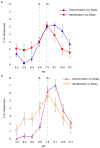Learning-related shifts in generalization gradients for complex sounds
- PMID: 19815929
- PMCID: PMC2936273
- DOI: 10.3758/LB.37.4.325
Learning-related shifts in generalization gradients for complex sounds
Abstract
Learning to discriminate stimuli can alter how one distinguishes related stimuli. For instance, training an individual to differentiate between two stimuli along a single dimension can alter how that individual generalizes learned responses. In this study, we examined the persistence of shifts in generalization gradients after training with sounds. University students were trained to differentiate two sounds that varied along a complex acoustic dimension. The students were subsequently tested on their ability to recognize a sound that they had experienced during training when it was presented among several novel sounds varying along this same dimension. Peak shift was observed in Experiment 1, in which generalization tests immediately followed training, and in Experiment 2, in which the tests were delayed by 24 h. These findings further support the universality of generalization processes across species, modalities, and levels of stimulus complexity. They also raise new questions about the mechanisms underlying learning-related shifts in generalization gradients. The sound stimuli from this study are available as .wav files from http://lb.psychonomic-journals.org/content/supplemental.
Figures



Similar articles
-
Temporal dynamics of generalization and representational distortion.Psychon Bull Rev. 2010 Dec;17(6):809-14. doi: 10.3758/PBR.17.6.809. Psychon Bull Rev. 2010. PMID: 21169573
-
Some effects of response-independent reinforcement on auditory generalization gradients.J Exp Anal Behav. 1975 Jan;23(1):81-6. doi: 10.1901/jeab.1975.23-81. J Exp Anal Behav. 1975. PMID: 1117248 Free PMC article.
-
Predicting shifts in generalization gradients with perceptrons.Learn Behav. 2012 Jun;40(2):128-44. doi: 10.3758/s13420-011-0050-6. Learn Behav. 2012. PMID: 21983938
-
A review of the generalization of auditory learning.Philos Trans R Soc Lond B Biol Sci. 2009 Feb 12;364(1515):301-11. doi: 10.1098/rstb.2008.0262. Philos Trans R Soc Lond B Biol Sci. 2009. PMID: 18977731 Free PMC article. Review.
-
Perceptual variability: Implications for learning and generalization.Psychon Bull Rev. 2021 Feb;28(1):1-19. doi: 10.3758/s13423-020-01780-1. Psychon Bull Rev. 2021. PMID: 32869189 Review.
Cited by
-
Olfactory Generalization in Detector Dogs.Animals (Basel). 2019 Sep 19;9(9):702. doi: 10.3390/ani9090702. Animals (Basel). 2019. PMID: 31546835 Free PMC article. Review.
-
Experimental analysis of using examples and non-examples in safety training.J Safety Res. 2016 Dec;59:97-104. doi: 10.1016/j.jsr.2016.10.002. Epub 2016 Oct 15. J Safety Res. 2016. PMID: 27847004 Free PMC article.
-
Easy-to-hard effects in perceptual learning depend upon the degree to which initial trials are "easy".Psychon Bull Rev. 2019 Dec;26(6):1889-1895. doi: 10.3758/s13423-019-01627-4. Psychon Bull Rev. 2019. PMID: 31243721 Free PMC article.
-
Associative learning and sensory neuroplasticity: how does it happen and what is it good for?Learn Mem. 2015 Oct 15;22(11):567-76. doi: 10.1101/lm.039636.115. Print 2015 Nov. Learn Mem. 2015. PMID: 26472647 Free PMC article. Review.
-
Aversive outcomes impact human olfactory discrimination learning and generalization.Behav Neurosci. 2021 Oct;135(5):642-653. doi: 10.1037/bne0000476. Epub 2021 Jul 1. Behav Neurosci. 2021. PMID: 34197137 Free PMC article.
References
-
- Ahn WK, Medin DL. A 2-stage model of category construction. Cognitive Science. 1992;16(1):81–121.
-
- Boneau AC, Cole JL. Decision theory, the pigeon, and the psychophysical function. Psychological Review. 1967;74(2):123–135. - PubMed
-
- Bizo LA, McMahon CV. Temporal generalization and peak shift in humans. Learning & Behavior. 2007;35(2):123–130. - PubMed
-
- Blough DS. Steady state data and a quantitative model of operant generalization and discrimination. Journal of Experimental Psychology: Animal Behavior Processes. 1975;1(1):3–21.
-
- Bouton ME, Nelson JB, Rosas JM. Stimulus generalization, context change, and forgetting. Psychological Bulletin. 1999;125(2):171–186. - PubMed
Publication types
MeSH terms
Grants and funding
LinkOut - more resources
Full Text Sources
